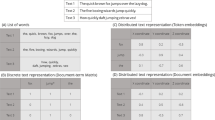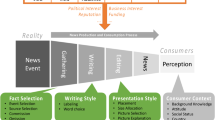Abstract
This paper is concerned with the structure of texts in which aproof is presented. Some parts of such a text are assumptions, otherparts are conclusions. We show how the structural organisation of thetext into assumptions and conclusions helps to check the validity of theproof. Then we go on to use the structural information for theformulation of proof rules, i.e., rules for the (re-)construction ofproof texts. The running example is intuitionistic propositional logicwith connectives ∧, → and⊥. We give new proofs of some familiar results aboutthe proof theory of this logic to indicate how the new techniques workout.
Similar content being viewed by others
References
Asher, N., 1993, Reference to Abstract Objects in Discourse, SLAP, Vol. 50, Dordrecht: Kluwer Academic Publishers.
Gabbay, D.M., 1990, “Labelled deductive systems: A position paper-Part I,” Technical Report CIS 90-22, Centr. Info. & Sprach., Universität München.
Gamut, L.T.F., 1991, Introduction to Logic, Logic, Language and Meaning, Vol. 1, Chicago, IL: University of Chicago Press.
Groenendijk, J. and Stokhof, M., 1991, “Dynamic predicate logic,” Linguistics and Philosophy 14, 39-100.
Hollenberg, M. and Vermeulen, C., 1996, “Counting variables in a dynamic setting,” Journal of Logic and Computation 6, 725-744.
Huang, X., 1994, “Human oriented proof presentation: A reconstructive approach,” Ph.D. Thesis, Universität des Saarlandes, Saarbrücken, Germany, SEKI Report SR-SR-94-07.
Kamp, H. and Reyle, U., 1991, “A calculus for first order discourse representation structures,” Technical Report, Sonderforschungsbereich 340, Wissenschaftliches Zentrum der IBM Deutschland GmbH.
Kracht, M.A., 1992, “The theory of syntactic domains,” Technical Report, Department of Philosophy, Utrecht University.
Kracht, M.A., 1993, “Nearness and syntactic influence spheres,” Technical Report, II. Mathematisches Institut, Freie Universität Berlin.
Lascarides, A. and Asher, N., 1991, “Discourse relations and defeasible knowledge,” pp. 55-63 in Proceedings of the 29th Annual Meeting of the Association for Computational Linguistics, ACL.
Oliveira, D., de Souza, C., and Haeusler, E., 1990, “Getting the message across in RST-based text generation,” pp. 47-74 in Current Research in Natural Language Generation, R. Dale, R. Mellish, and M. Zock, eds., London: Academic Press.
Oliveira, D., de Souza, C., and Haeusler, E., 1999, “Structured argument generation in a logic-based KB system,” pp. 222-250 in Logic, Language and Computation, Vol. 2, L. Moss, J. Ginzberg, and M. de Rijke, eds., Stanford, CA: CSLI Publications.
Prüst, H. and Scha, R., 1990, “A discourse perspective on verb-phrase anaphora,” pp. 451-474 in Proceedings of the Seventh Amsterdam Colloquium, M. Stokhof and L. Torenvliet, eds., Amsterdam: ITLI Publications, University of Amsterdam.
Reinhart, T., 1983, Anaphora and Semantic Interpretation, Chicago, IL: Chicago University Press.
Ryan, M., 1991, “Belief revision and ordered theory presentations,” pp. 37-45 in Proceedings of the 8th Amsterdam Colloquium, J. Groenendijk et al., eds., Amsterdam: Institute for Logic Language and Computation, University of Amsterdam.
Troelstra, A. and van Dalen, D., 1988, Constructivism in Mathematics, Studies in Logic and Foundations of Mathematics, Vol. 121, Amsterdam: North-Holland.
van den Berg, M., 1996, “Some aspects of the internal structure of discourse,” Ph.D. Thesis, Institute for Logic, Language and Computation, University of Amsterdam.
Veltman, F., 1996, “Defaults in update semantics,” Journal of Philosophical Logic 25, 221-261.
Vermeulen, C., 1993, “Update semantics for propositional texts,” pp. 363-386 in Applied Logic: How, What and Why, P. Lászlo and M. Masuch, eds., Dordrecht: Kluwer Academic Publishers.
Vermeulen, C., 1994a, “Explorations of the dynamic environment,” Ph.D. Thesis, UiL-OTS (Utrecht Institute for Linguistics), University of Utrecht.
Vermeulen, C., 1994b, “Incremental semantics for propositional texts,” Notre Dame Journal of Formal Logic 35, 243-271.
Vermeulen, C.F.M., 2000, “Variables as stacks: A case study in dynamic model theory,” Journal of Logic, Language and Information 9, 143-167.
Vermeulen, C. and Visser, A., 1996, “Dynamic bracketing and discourse representation,” Notre Dame Journal of Formal Logic 37, 321-365.
Visser, A., 1998, “Contexts in dynamic predicate logic,” Journal of Logic, Language and Information 7, 21-52.
Author information
Authors and Affiliations
Rights and permissions
About this article
Cite this article
Vermeulen, C. Text Structure and Proof Structure. Journal of Logic, Language and Information 9, 273–311 (2000). https://doi.org/10.1023/A:1008309715242
Issue Date:
DOI: https://doi.org/10.1023/A:1008309715242




